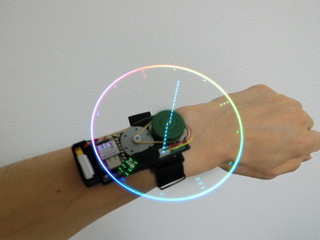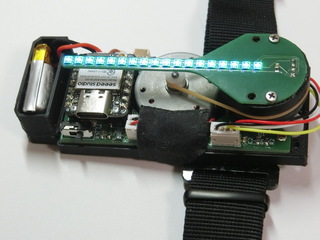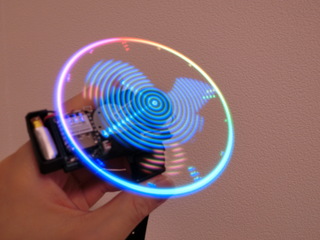


A “wrist watch” with a luminous dial, measuring 10cm in diameter.
The size of a display on personal electronic devices is a fundamental challenge: there is a trade-off between portability and visibility (screen size). A small device that can have larger display when in use, like a holographic display, would be one of the solution. Unfortunately there is no such product in the market. So I tried to build on my own. As the first PoC of such device formfactor, I made a “wrist watch”.
| Dimension | W80xD32xT20[mm] |
|---|---|
| Battery | Li-Po battery 3.7V 100mAh |
| MCU | ESP32S3 |
| Name | desceription |
|---|---|
| Li-Po battery 3.7V 100mAh | charged when connected to USB |
| XIAO ESP32S3 | control |
| slip ring | signal and power connection over the spinning joint |
| bearing | metal ball bearing, ensures smooth rotation and rigdity of the mechanism |
| pully | motor torque transmission using a rubber belt |
| infrared photo reflector | detects the rotation position and frequency of the spindle |
LEDs must be controlled at the exact timing for PoV display. The program need to know how much the LED bar is rotated at each instant. For this purpose, a photo-reflective marker is attached in the back side of the spindle, and it's sensed by an infrared photo sensor.
The sensor can detect that the bar has passed at a certain angle.
When it's sensed for the second time, the interval of the rotation can be calculated.
The relative angle of the bar from the origin can be computed at every time instance based on the MCU's internal clock, assuming the constant angular speed.
pseudo-code
while True:
t = current_time()
if sensor_triggered():
interval = t - last_t
last_t = t
current_angle = (t - last_t) / interval * 360
(show LED pattern for the current_angle)
山口 辰久